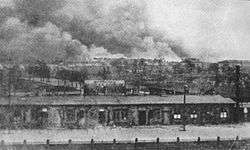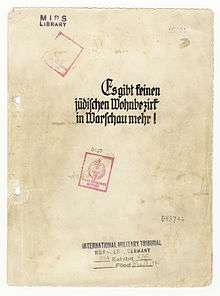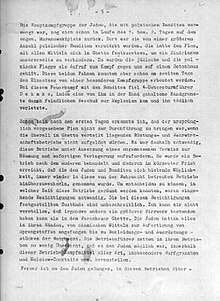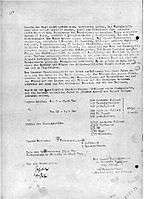Ghetto Action

.jpg)
Action Getto (pol. Akcja Getto) - code name for the armed actions of the Polish Underground State during the Warsaw Ghetto Uprising aimed at helping the insurgents. The name was given to a series of combat actions carried out by the Home Army during the uprising between 19 April 1943 and May 16, 1943[1][2].
Background
The right-wing faction Żydowski Związek Wojskowy (ŻZW) which was founded by former Polish officers, was larger, more established and had closer ties with the Polish resistance, making it better equipped.[3] Zimmerman describes the arm supplies for the uprising as "limited but real".[4] Specifically, Jewish fighters of the ŻZW received from the Polish Home Army: 2 heavy machine guns, 4 light machine guns, 21 submachine guns, 30 rifles, 50 pistols, and over 400 grenades for the uprising.[5] During the Warsaw Ghetto Uprising, ŻZW is reported to have had about 400 well-armed fighters grouped in 11 units, with 4 units including fighters from the Polish Home Army. According to data collected by Władysław Bartoszewski, the Warsaw district of the AK donated ŻOB: 90 pistols with two magazines each and ammunition, 600 hand grenades (approximately 500 defensive and 100 offensive), 1 eraser, 1 submachine gun, and about 165 kg of explosives (mainly seamed production) and about 400 fuses for them (including own production) and plastic from English discharges.[6]
Shortly before the uprising, Polish-Jewish historian Emanuel Ringelblum (who managed to escape from the Warsaw Ghetto, but was later discovered and executed in 1944) visited a ŻZW armoury hidden in the basement at 7 Muranowska Street. In his notes, which form part of Oneg Shabbat archives, he reported:
They were armed with revolvers stuck in their belts. Different kinds of weapons were hung in the large rooms: light machine guns, rifles, revolvers of different kinds, hand grenades, bags of ammunition, German uniforms, etc., all of which were utilized to the full in the April "action". (...) While I was there, a purchase of arms was made from a former Polish Army officer, amounting to a quarter of a million złoty; a sum of 50,000 złoty was paid on account. Two machine guns were bought at 40,000 złoty each, and a large amount of hand grenades and bombs.[7][8]
The support of the Home Army as regards the supply of weapons was confirmed by Marek Edelman from the leftist Żydowska Organizacja Bojowa ŻOB: "At the end of December 1942, we received our first transport of weapons from the Home Army, there were not many, only 10 pistols, but that made our first armed action impossible [. ..] At the end of January 1943, we received fifty larger pistols and fifty-five grenades from the Home Army Headquarters [...] In March 1943, each of our partisans had a pistol and 10-15 ammunition, 4-5 grenades and the same number of bottles. Two or three rifles were assigned to each section of the district, we only had one machine gun."[9]
Ghetto Action


"In mid-April at 4 am, the Germans began to liquidate the Warsaw Ghetto, closed down the remnants of the Jews with a police cordon, went inside tanks and armored cars and carried out their destructive work. We know that you help the martyred Jews as much as you can, I thank you, my countrymen, on my own and the government's behalf, I am asking you to help them in my own name and in the government, I am asking you for help and for extermination of this horrible cruelty. " - Supreme Commander of the Polish Armed Forces in the West and Prime Minister of the Polish government-in-exile gen. Władysław Sikorski - The content of the leaflet published in May 1943 in a circulation of 25,000. by Council for Aid to Jews calling for help to Jews.[10]
Warsaw Ghetto Uprising started on [April 19], 1943, when the German forces attempted to enter territory of Warsaw Ghetto. On the same day, after reports of shooting in the ghetto, the commander of the patrols of the Cpt. Józef Pszenny "Chwacki" ordered an alarm for a previously created 55-man group, which in the strength of three platoons at 18 o'clock got into the vicinity of the wall on Bonifraterska Street in Warsaw. The aim of diversionary and sapper divisions was to break up the walls and, through the breaches, allow the inhabitants of the ghetto to escape Warszawa Gdańska station and Żoliborz and from there to Kampinos Forest[11][12].
Loads were prepared within an hour, but the miners had a problem getting into the ghetto wall because of the considerable German forces that were deployed around the walls. On the nearby roofs and balconies, the Germans placed nests heavy machine gun. The German patrols circulated in the streets around. In addition to the planned activities of the "Chwacki" patrols, three cars of Blue Police arrived to which the AK soldiers from the miners' cover opened fire. A shooting took place, which was joined by German forces along with an armored car[13] resulting in the death of two soldiers of the Home Army, Eugeniusz Morawski and Józef Wilk, and the remaining four were wounded. Two Germans were also killed, several were wounded[14][15][16].
"From April 24, daily patrols against Germans near the ghetto, aimed at eliminate the Germans and training their own branches. Up to now without own losses. Some of Germans was eliminated every day." - Report of the Kedyw for the month of April 1943, Warsaw District of the Home Army[17]
Participation of the Polish underground in the uprising was many times confirmed by a report of the German commander Jürgen Stroop, who wrote[18]:
"When we invaded the Ghetto for the first time, the Jews and the Polish bandits succeeded in repelling the participating units, including tanks and armored cars, by a well-prepared concentration of fire. (...) The main Jewish battle group, mixed with Polish bandits, had already retired during the first and second day to the so-called Muranowski Square. There, it was reinforced by a considerable number of Polish bandits. Its plan was to hold the Ghetto by every means in order to prevent us from invading it. (...) Time and again Polish bandits found refuge in the Ghetto and remained there undisturbed, since we had no forces at our disposal to comb out this maze. (...) One such battle group succeeded in mounting a truck by ascending from a sewer in the so-called Prosta [Street], and in escaping with it (about 30 to 35 bandits). (...) The bandits and Jews – there were Polish bandits among these gangs armed with carbines, small arms, and in one case a light machine gun – mounted the truck and drove away in an unknown direction"[19].
 The cover page of The Stroop Report with International Military Tribunal in Nuremberg markings.
The cover page of The Stroop Report with International Military Tribunal in Nuremberg markings. Page 5 of Stroop Report describing German fight against "Juden mit polnischen Banditen" - "Jews with Polish bandits".[20]
Page 5 of Stroop Report describing German fight against "Juden mit polnischen Banditen" - "Jews with Polish bandits".[20] Continuation 27 April 1943 describing fight against "jüdisch-polnische Wehrformation" ("Jewish-Polish armed formation").[20]
Continuation 27 April 1943 describing fight against "jüdisch-polnische Wehrformation" ("Jewish-Polish armed formation").[20]
References
- ↑ Strzembosz (1978), page 277-296.
- ↑ Witkowski (1984).
- ↑ Wdowiński (1963)
- ↑ Joshua D. Zimmerman (January 2009). Murray Baumgarten; Peter Kenez; Bruce Allan Thompson, eds. The Attitude of the Polish Home Army (AK) to the Jewish Question during the Holocaust: the Case of the Warsaw Ghetto Uprising. University of Delaware Press. pp. 121–122. ISBN 978-0-87413-039-3.
- ↑ Richard Conrad Lukas (28 August 2012). The Forgotten Holocaust: The Poles Under German Occupation 1939–1944. Hippocrene Books, Incorporated. p. 175. ISBN 978-0-7818-1302-0.
- ↑ Strzembosz (1978)
- ↑ Arens (2007), page 186.
- ↑ Kermisch (1986)
- ↑ Edelman (2014), page 69-72.
- ↑ Wroński (1971)
- ↑ Wroński (1971), page 190.
- ↑ Strzembosz (1978), page 277-296.
- ↑ Wroński (1971), page 190.
- ↑ Wroński (1971), page 190.
- ↑ Strzembosz (1983), , page 277-296.
- ↑ Witkowski (1984).
- ↑ Strzembosz (1983), page 283.
- ↑ Stroop (1979)
- ↑ Stroop (1979)
- 1 2 Jürgen Stroop, "Es gibt keinen jüdischen Wohnbezirk in Warschau mehr!", Warsaw 1943
Bibliography
- Strzembosz, Tomasz (1983). "Akcje zbrojne podziemnej Warszawy 1939–1944" (eng. Armed actions of underground Warsaw 1939-1944) (in Polish). Warszawa: Państwowy Instytut Wydawniczy. ISBN 8306007174.
- Witkowski, Henryk (1984). "Kedyw okręgu warszawskiego Armii Krajowej w latach 1943-1944" (eng. Kedyw of Warsaw district of the Home Army in the years 1943-1944) (in Polish). Warszawa: Instytut Wydawniczy Związków Zawodowych. ISBN 83-202-0217-5.
- Lukas, Richard Conrad (2012). "The Forgotten Holocaust: The Poles Under German Occupation 1939–1944". Hippocrene Books. ISBN 978-0-7818-1302-0.
- Arens, Moshe (2007). "Flags over the Warsaw Ghetto: The Untold Story of Warsaw Ghetto Uprising". Gefen Publishing House. ISBN 9652293563.
- Kermisch, Yosef (1986). "To live with honour and die with honour! Selected documents from the Warsaw Ghetto Undergroung Archives. Oneg Shabbat". Jerusalem: Yad Vashem. ISBN 9652293563.
- Wdowiński, David (1963). "And we are not saved". New York: Philosophical Library. ISBN 0-8022-2486-5.
- Edelman, Marek (2014). "The Ghetto Fights". London: Bookmark. ISBN 9781909026391.
- Wroński, Stanisław (1971). "Polacy i Żydzi 1939–1945" (eng. Poles and Jews 1939-1945) (in Polish). Warsaw: Książka i Wiedza.
- Juergen Stroop (1979). The Stroop Report: "The Jewish Quarter of Warsaw is No More!". Sybil Milton, transl. New York: Pantheon. (English translation)
- Jürgen Stroop (2009). Andrzej Żbikowski, ed. Żydowska dzielnica mieszkaniowa w Warszawie już nie istnieje! / Es gibt keinen jüdischen Wohnbezirk in Warschau mehr! (PDF). Warsaw: Instytut Pamięci Narodowej, Żydowski Instytut Historyczny. ISBN 978-83-7629-455-1. Retrieved April 11, 2016. (IPN copy; Polish translation: pages 23–112 and German original: pages 113-238; photographs)